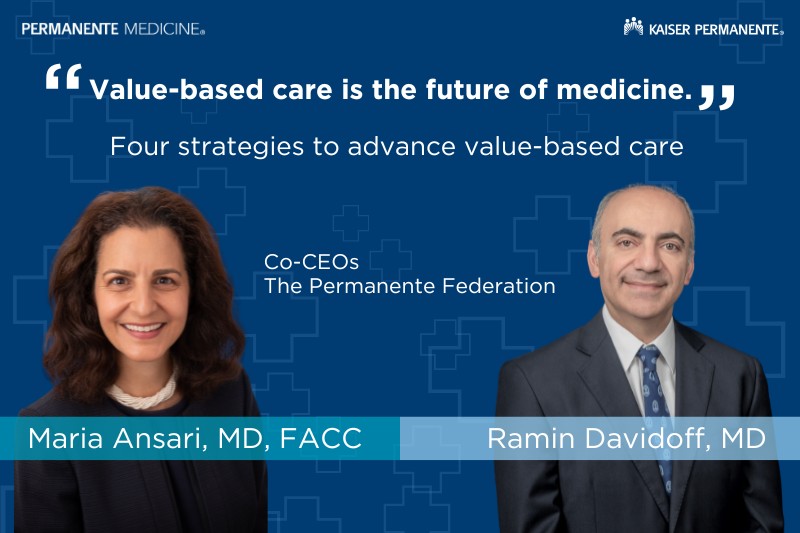The Permanente Federation co-CEOs share 7 strategies to build a trustworthy, affordable and accessible health care system for the next generation

Drs. Ansari and Davidoff on ways to advance value-based care
Value-based care is the future of medicine, and everyone is trying to get it right, co-CEOs of The Permanente Federation, Maria Ansari, MD, FACC, and Ramin Davidoff, MD write in a recent Medical Economics commentary. The physician leaders add that as momentum for a shift to value-based care accelerates, physicians and other health care leaders should explore ways to fully realize the model’s potential. Value-based care is aimed at enhancing patient outcomes and overall health by linking financial rewards to quality of care, rather than the volume of services rendered. This differs from the fee-for-service approach, which has traditionally been the primary method of payment for healthcare.
Medical groups that are funded by prepaid, value-based care arrangements are better positioned to develop and invest in innovative programs and technologies to respond to patient needs and market dynamics.
“For example, value-based organizations that bet big on telehealth and remote patient monitoring technologies prior to 2019 were able to continue seeing patients remotely during the COVID-19 pandemic,” Drs. Ansari and Davidoff write. “In contrast, fee-for-service health care systems — which are paid per office visit, treatment, and test — struggled. As a result, a movement is now underway in health care, from volume of care to value of care.”
Related value-based care story: Dr. Ansari shares keys to leading in a value-based care organization
Drawing on Kaiser Permanente’s nearly 80-year history as a value-based organization, Drs. Ansari and Davidoff delved into 4 innovative strategies physician leaders can adopt to deliver on the promise of value-based care. These include:
- Embrace AI to help improve care quality and help physicians with administrative tasks. For example, at Kaiser Permanente Northern California, computer vision algorithms were used to identify patients at risk for breast cancer more quickly and efficiently. Permanente physicians and clinicians are also using ambient AI technology to help write clinical visit notes, enabling more focused, one-on-one time with patients.
- Focus on optimal wellness by delivering the right care in the right venue, including care-at-home for an aging population. Value-based care models allow organizations to invest in people, technology, and services that support team-based care across multiple venues, including in patients’ homes. Kaiser Permanente has invested in developing at-home services in 6 regions across the country, doubling its commitment to this care model from 2022.
- Solve the shortage of primary care physicians. Primary care physicians are essential as the first line of defense against illness or injury. However, 30% of Americans currently lack a primary care doctor due to a shortage. Drs. Ansari and Davidoff urge policymakers to consider measures that bring a new generation of talented and diverse physicians into the field. “Increasing the number of graduate medical education slots — proposed by the Resident Physician Shortage Reduction Act — would be a good start,” they write.
- Identify and address health disparities and emphasize prevention. Insights from outcomes reporting at Kaiser Permanente are used to create comprehensive plans to address disparities. For instance, research published in The New England Journal of Medicine showed that a decade of enhanced colorectal cancer screening with fecal immunochemical tests (FIT) eliminated disparities between Black and white Kaiser Permanente members in Northern California and improved colorectal cancer outcomes for all members.
Related geriatric care story: Ramin Davidoff, MD, on the benefits of integrated, value-based care
Drs. Ansari and Davidoff underscore the fact that prepaid, value-based systems support the innovation needed to adapt to market disruptions and create a sustainable, equitable health care environment. “During this time of rapid change and increasing uncertainty,” they write, “health care organizations will need to shift to value-based care to better serve patients and remain competitive.”
Note: To read the full article, visit Medical Economics.


